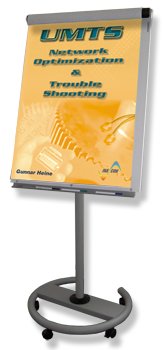 UMTS -
UMTS -
Network Optimization & Trouble Shooting
[3-day training course, Euro 3,450.- per participant]
 Training Course Description
Training Course Description

- This training course is targeted at engineers and technicians who are involved in the operation, optimization and troubleshooting of UTRA-networks.
- This fascinating blend of practical experience and theoretical knowledge is a must for everybody who shall tune a UTRA-network.
- The training course starts with a detailed description of important UTRA-parameters throughout the various protocols and continues with the consideration of how specific parameter settings and setting combinations influence the system operation.
- In another part, the training course answers your questions with respect to network dimensioning and load aspects in both the terrestrial and the wireless parts of UTRA.
- Finally, the training course provides guidance on how and where to setup performance measurements for circuit-switched and packet-switched performance measurements within UTRA.
- The training course concludes with the detailed analysis of typical errors and failures in UTRA networks, discriminating mobile station issues from network problems.
Please click here for a detailed Table of Contents (ToC)
Some of your questions that will be answered
- What does network performance in UMTS stand for and how does it compare to GSM- or GPRS-network performance?
- How can I determine our actual network performance?
- What is meaning of the parameter “Received-total-wide-band-power” which is conveyed from the NodeB to the RNC during radio link setup?
- How can I measure and compare the quality (Bit Error Rate / Frame Erasure Rate) per cell, per NodeB or per RNS on the Iub-Interface for both uplink and downlink?
- How can I distinguish application and user equipment failures which are outside of our scope from real network problems?
- What is the meaning of the various timers and counters which are broadcast in the System Information Blocks
- Which system parameters can I tune to optimize the UE’s idle mode behavior? (e.g. S-intrasearch, t-Reselection-S, Qhyst, Qoffset, ...)?
- How can I nail down performance bottlenecks in the different parts of our network?
- How can I minimize the interference through the use of diversity transmission methods?
- How can I optimize the network access procedure for both, minimum delay times and minimum interference.
- What is the optimum configuration of the different RLC counter and timer values (e.g. Max-DAT, timerPoll, transmissionWindowSize, …) to provide the best possible service for transparent, unacknowledged and acknowledged operation modes.
- What are the best measurement tools for the Uu-interface and within UTRA?
 Who should attend this class?
Who should attend this class?
- Network operator staff who are involved in the optimization of UTRA and who need to continuously improve the network performance.
- System vendors who are involved in second and third level troubleshooting activities
 Pre-Requisites
Pre-Requisites
- Previous practical exposure to network optimization and trouble shooting in GSM, GPRS or UMTS (second level) is required.
- Very good understanding of the related UTRA- and NAS-protocols is necessary.
- We strongly recommend to join our training training courses “UMTS – Design Details & System Engineering” and
“UMTS - Signaling & Protocol Analysis” before visiting this course. - Previous practical experience with network protocol testers and test UE’s (e.g. TEMS) is desirable.
 Training Course Target
Training Course Target
- The student is enabled to troubleshoot and optimize UTRA FDD networks and UE’s.
 Training Course Duration
Training Course Duration
- 3 days
v1.62
ℹ️ Try out the updated search below!
Search:
More Info:
Detailed ToC of this training course
Schedule of this training course
Extract of this training course
Buy this book
Buy this book as eBook
INACON eBooks
Please have a look at our full offer

